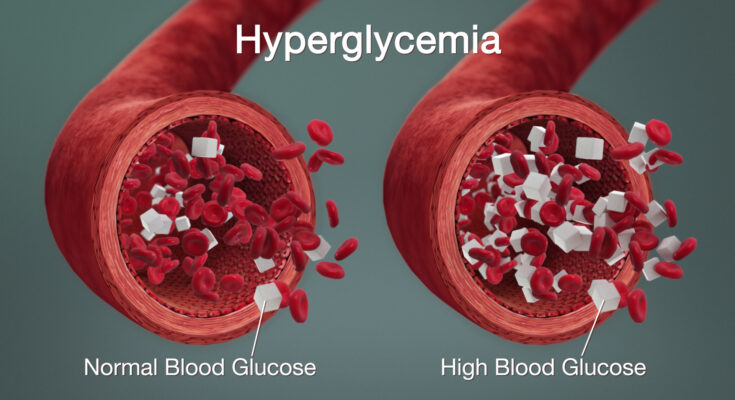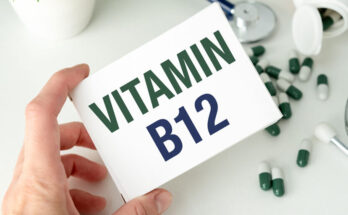Hyperglycemia in Diabetes Symptoms: Hyperglycemia, commonly known as high blood sugar, is a critical condition that predominantly affects individuals with diabetes. This condition occurs when the glucose level in the blood is higher than normal.
Understanding the symptoms and causes of hyperglycemia within the diabetic spectrum is vital for effective management and prevention of severe complications.
Understanding Hyperglycemia
Hyperglycemia, or high blood sugar, is a condition commonly associated with diabetes, where the glucose level in the bloodstream is elevated beyond normal thresholds. This condition arises when the body either does not produce sufficient insulin or fails to use insulin effectively. Insulin is the hormone responsible for regulating blood sugar levels by facilitating the transport of glucose into cells for energy.
How Blood Sugar Levels are Regulated in the Body
- Insulin Production: The pancreas produces insulin, which helps cells absorb glucose from the bloodstream.
- Glucose Utilization: Once inside the cells, glucose is used as fuel for energy or converted into glycogen for storage in liver and muscle tissues.
- Release of Glucose: When blood sugar levels are low, the liver breaks down glycogen back into glucose and releases it into the bloodstream.
- Hormonal Adjustment: Other hormones such as glucagon, cortisol, and epinephrine also play roles in increasing blood glucose levels during times of stress or fasting.
Importance of Monitoring Blood Glucose Levels for Diabetics
Monitoring blood glucose levels is crucial for individuals with diabetes to manage their condition effectively. Here are the key reasons why:
- Preventing Complications: Regular monitoring helps prevent the risk of both short-term issues, like diabetic ketoacidosis, and long-term complications, including nerve damage, kidney disease, and vision problems.
- Medication Adjustment: Checking blood sugar levels allows for timely adjustments in medication, insulin doses, and dietary choices.
- Lifestyle Management: It aids in evaluating how well diet, exercise, and other lifestyle choices are working to control diabetes.
- Early Intervention: Frequent monitoring provides immediate feedback, enabling early intervention when glucose levels are too high or too low.
By understanding and controlling hyperglycemia through careful monitoring and management, individuals with diabetes can maintain a healthier lifestyle and minimize the risk of diabetes-related complications.
Symptoms of Hyperglycemia in Diabetes
Recognizing the symptoms of hyperglycemia is crucial for managing this condition effectively and preventing complications. Here, we provide a detailed look at the early symptoms of hyperglycemia, as well as the signs that indicate its advancement.
Comprehensive List of Early Symptoms of Hyperglycemia
The early symptoms of hyperglycemia are often subtle and can be easily overlooked. However, identifying these early signs is key to managing blood sugar levels before they escalate to more severe issues. Here are some common early symptoms of hyperglycemia:
- Increased Thirst and Frequent Urination: Excess sugar in your bloodstream causes fluid to be pulled from your tissues. This may leave you thirsty. As you drink more fluids to quench your thirst, you’ll urinate more frequently.
- Fatigue: High blood sugar levels can affect your blood’s circulation and reduce the energy supply to your cells, making you feel unusually tired or fatigued.
- Blurred Vision: Hyperglycemia can cause fluid levels in the eyes to fluctuate, leading to swelling of the eye lenses and blurred vision.
- Headaches: When your blood sugar levels are high, headaches can frequently occur, which can vary in intensity.
- Difficulty Concentrating: High blood sugar can impact your cognitive abilities, making it hard to focus or concentrate.
Signs of Advanced Hyperglycemia
If hyperglycemia is not addressed, it can progress and lead to more serious health issues. Recognizing the signs of advanced hyperglycemia can help you seek prompt medical intervention. Advanced symptoms include:
- Ketoacidosis: In severe cases, your body starts breaking down fats at a rapid rate, releasing acidic chemicals known as ketones into the bloodstream, which can lead to a dangerous condition called ketoacidosis.
- Severe Dehydration: As your body attempts to rid itself of excess sugar through urine, it can result in significant fluid loss, leading to dehydration.
- Weight Loss: Despite eating more than usual to relieve hunger, you may experience weight loss due to the inability to use glucose effectively.
- Skin Infections: High sugar levels can weaken your body’s ability to fight infections, increasing the risk of skin infections and other illnesses.
- Slow-healing Cuts and Wounds: Elevated blood sugar levels can lead to poor blood circulation and affect your body’s natural healing process, resulting in slow-healing injuries.
If you notice any of these symptoms, consult your healthcare provider for a comprehensive evaluation and appropriate treatment.
Causes of Hyperglycemia in Diabetics
Understanding the causes and factors that lead to hyperglycemia is crucial for managing diabetes effectively. Here’s a detailed look at the primary causes and contributing factors.
Primary Causes of Hyperglycemia
- Insufficient Insulin Use or Production: The most common cause of hyperglycemia in diabetics is inadequate insulin levels. In type 1 diabetes, the body doesn’t produce insulin at all. In type 2 diabetes, the body either doesn’t produce enough insulin or can’t use insulin effectively.
- Inadequate Medication: Not using the correct dose of diabetes medication can also lead to high blood sugar levels. This includes missing doses or not following the prescribed regimen.
- Dietary Choices: Consuming foods high in carbohydrates or calories can raise blood sugar levels. This is particularly impactful when meals are not properly balanced with the appropriate diabetes medication.
- Physical Inactivity: Lack of regular exercise can contribute to hyperglycemia since physical activity helps the body use glucose effectively.
Contributing Factors
- Incorrect Carbohydrate Counting: Misjudging the amount of carbohydrates in a meal can lead to insufficient medication dosing, resulting in higher blood sugar levels.
- Hormonal Changes: Hormonal fluctuations, such as those experienced during puberty, pregnancy, or menopause, can affect how the body manages glucose.
- Other Medications: Certain medications, including steroids and some diuretics, can increase blood sugar levels.
Impact of Stress and Illness
Stress and illness are significant factors that can lead to hyperglycemia in diabetics. When under stress, whether physical or emotional, the body releases hormones such as adrenaline and cortisol. These hormones can cause blood sugar levels to rise. Similarly, when a diabetic person is ill, the body produces stress-related hormones to fight the illness, which can also increase glucose levels.
By monitoring their blood sugar regularly, adhering to a well-planned diet, maintaining an active lifestyle, and adjusting medication as necessary, individuals with diabetes can better control their blood sugar levels and reduce the risk of complications associated with hyperglycemia.
Diagnosing Hyperglycemia in Diabetes
Diagnosing hyperglycemia, which is a key indicator of diabetes, involves several important tests and tools. Identifying high blood sugar levels early is crucial for managing diabetes effectively and preventing complications. Here’s a breakdown of the primary methods used to diagnose hyperglycemia in diabetic patients:
1. Fasting Blood Sugar Test (FBS)
A fasting blood sugar test is typically the first step in diagnosing hyperglycemia. This test measures blood glucose levels after the patient has fasted (not eaten) for at least eight hours. A fasting blood glucose level from 100 to 125 mg/dL (5.6 to 6.9 mmol/L) is considered prediabetes, while a level of 126 mg/dL (7 mmol/L) or higher can indicate diabetes.
2. Oral Glucose Tolerance Test (OGTT)
The oral glucose tolerance test is a detailed test used to diagnose type 2 diabetes and gestational diabetes. During the OGTT, a patient’s blood sugar is measured after fasting and again two hours after drinking a glucose-rich beverage. Blood sugar levels higher than 200 mg/dL (11.1 mmol/L) two hours after consumption suggest diabetes.
3. Random Blood Sugar Test
This test measures blood glucose regardless of when the person last ate. A blood sugar level of 200 mg/dL (11.1 mmol/L) or higher suggests diabetes, especially when accompanied by symptoms of hyperglycemia such as increased thirst, urination, and fatigue.
4. Hemoglobin A1c Test
The Hemoglobin A1c test provides a broader view by measuring the average blood glucose levels over the past two to three months. An A1c level of 6.5% or higher on two separate tests indicates diabetes. Levels between 5.7% and 6.4% suggest prediabetes.
5. Continuous Glucose Monitoring (CGM)
For ongoing monitoring, many patients use a continuous glucose monitor. This device tracks glucose levels throughout the day and night, providing real-time insights into blood sugar trends. This can help to detect hyperglycemia before it becomes severe.
6. Ketone Testing
In cases of suspected severe hyperglycemia, ketone testing may be necessary. This test checks for the presence of ketones in the urine or blood, which can indicate diabetic ketoacidosis, a life-threatening complication that requires immediate medical attention.
Effective diagnosis of hyperglycemia is vital for the successful management of diabetes. Utilizing a combination of these tools and tests allows healthcare providers to establish an accurate diagnosis and tailor a management plan that can help mitigate the risks associated with high blood sugar levels. Regular monitoring and adjustments based on these tests are essential for maintaining optimal health in diabetic patients.
Managing and Treating Hyperglycemia in Diabetes
Effective management of hyperglycemia is crucial to prevent complications such as cardiovascular disease, nerve damage, and kidney issues. This guide provides comprehensive strategies for managing and treating high blood sugar through lifestyle adjustments and medication therapies.
Lifestyle Adjustments to Manage High Blood Sugar
- Healthy Eating: Focus on a balanced diet that includes a variety of nutrients. Incorporate a high intake of fruits, vegetables, and whole grains. Limit foods high in sugar and fat.
- Regular Physical Activity: Engage in regular exercise such as walking, cycling, or swimming. Aim for at least 150 minutes of moderate aerobic activity or 75 minutes of vigorous activity each week.
- Weight Management: Maintain a healthy weight or lose weight if you are overweight. Even a small amount of weight loss can significantly improve blood sugar control.
- Routine Monitoring: Regularly check your blood sugar levels to keep track of any changes and adjust your lifestyle accordingly.
- Stress Reduction: Stress can significantly affect blood sugar levels. Techniques such as yoga, meditation, and deep breathing can help manage stress effectively.
- Adequate Sleep: Ensure you get at least 7-9 hours of quality sleep per night. Poor sleep can disrupt blood sugar levels and insulin sensitivity.
- No Smoking: Smoking can exacerbate blood sugar control and lead to complications. Quitting smoking can improve overall health and help in the management of diabetes.
Medication and Insulin Therapy Adjustments
- Medication Review: Regular consultation with a healthcare provider is essential to ensure that medications are working effectively. Adjustments may be required based on blood sugar monitoring results.
- Insulin Management: For those who require insulin, understanding the types of insulin and their effects on blood sugar levels is crucial. Adjusting insulin dosages based on dietary intake and exercise routines can improve control.
- New Medications: Be open to new treatment options. Several newer classes of medications, such as SGLT2 inhibitors and GLP-1 receptor agonists, have been effective in managing blood sugar levels.
- Regular Appointments: Regular appointments with a healthcare provider allow for timely adjustments to treatment plans based on the latest medical advice and personal health status.
- Education and Support: Participate in diabetes education programs and support groups to better understand the disease and learn from others who are facing similar challenges.
However, engaging with healthcare professionals and maintaining a proactive approach towards treatment adjustments are key components of successful diabetes management.
Prevention of Hyperglycemia in Diabetes
Managing blood sugar levels is crucial for individuals living with diabetes to prevent hyperglycemia, which is an abnormally high glucose level in the blood. Preventing hyperglycemia not only helps in maintaining overall health but also reduces the risk of severe complications such as nerve damage, kidney disease, and cardiovascular problems. Here are some effective strategies to prevent hyperglycemia:
1. Regular Monitoring of Blood Glucose
Consistently checking blood glucose levels is vital. Regular monitoring allows individuals to understand how their meals, activities, and medications affect their blood sugar levels. This frequent checking can help in making informed decisions about diet and medication, which are crucial for maintaining glucose levels within a target range.
2. Comprehensive Diabetes Education
Knowledge is power when it comes to managing diabetes. Educating oneself about the disease, its impacts, and how to manage it can significantly enhance an individual’s ability to control their glucose levels. Education programs should cover:
- The importance of a balanced diet and how different foods affect blood sugar levels.
- The role of physical activity in managing diabetes and its impact on blood glucose.
- How to recognize the early symptoms of hyperglycemia and the steps to take if levels are too high.
3. Effective Management Strategies
Implementing effective management strategies is key:
- Dietary Adjustments: Adopting a diet low in refined sugars and high in dietary fiber can help maintain stable blood sugar levels.
- Regular Exercise: Engaging in regular physical activity can help increase insulin sensitivity, which means the body’s cells are better able to use available sugar in the bloodstream.
- Medication Adherence: For those prescribed diabetes medication or insulin therapy, it is crucial to take them as directed by a healthcare provider to keep blood glucose levels in check.
By incorporating these strategies, individuals with diabetes can significantly reduce the risk of hyperglycemia and maintain better health outcomes.
FAQs about Hyperglycemia in Diabetes Symptoms
What is hyperglycemia in the context of diabetes?
Hyperglycemia refers to high blood sugar levels, a common issue among those with diabetes. It occurs when the body has insufficient insulin or cannot effectively use the insulin it has.
What are the early signs of hyperglycemia?
Early symptoms of hyperglycemia include frequent urination, increased thirst, blurred vision, fatigue, and headaches. Recognizing these early signs can help manage and prevent complications.
How does hyperglycemia affect the body over time?
If left untreated, hyperglycemia can lead to severe complications, such as diabetic ketoacidosis (DKA), hyperglycemic hyperosmolar syndrome (HHS), and chronic issues like nerve damage, kidney disease, and cardiovascular problems.
Can hyperglycemia occur in people with type 1 and type 2 diabetes?
Yes, hyperglycemia can occur in both type 1 and type 2 diabetes. Individuals with type 1 diabetes do not produce insulin, while those with type 2 may not produce enough or are insulin resistant.
What should I do if I experience symptoms of hyperglycemia?
If you notice symptoms of hyperglycemia, it’s important to test your blood sugar levels and consult with your healthcare provider. They may recommend adjustments in your medication, diet, or exercise routine.
Can dietary choices help manage hyperglycemia?
Yes, dietary choices play a crucial role in managing blood sugar levels. Foods low in simple sugars and carbohydrates, and high in fiber, such as whole grains, vegetables, and lean proteins, can help stabilize blood sugar.
How often should someone with diabetes monitor their blood sugar levels?
Frequency of monitoring can vary depending on the type of diabetes and the individual’s treatment plan. Typically, those with diabetes are advised to check their blood sugar several times a day, especially before and after meals, and before bedtime.
Conclusion:
In summary, hyperglycemia in diabetes manifests through various symptoms including frequent urination, increased thirst, fatigue, blurred vision, and slow-healing wounds. The primary causes of this condition are insufficient insulin production or improper insulin utilization by the body. These factors disrupt normal glucose metabolism, leading to elevated blood sugar levels.
Managing diabetes and preventing hyperglycemia requires a comprehensive approach. It is crucial for individuals with diabetes to monitor their blood sugar levels regularly, adhere to a balanced diet, engage in regular physical activity, and maintain a healthy weight. Additionally, taking prescribed medications as directed can help manage insulin levels and reduce the risk of complications.
We encourage all individuals with diabetes to consult regularly with their healthcare providers. A collaborative approach to managing diabetes can help you stay on top of your condition and lead a healthier life. Remember, effective management of diabetes is a continual process that requires dedication and careful attention to your body’s needs.
References
For further reading and to validate the information provided on the symptoms of hyperglycemia in diabetes, the following reputable sources are recommended. These links offer comprehensive insights and detailed research that can enhance your understanding of this condition:
- American Diabetes Association (ADA) – The ADA provides extensive resources on managing diabetes, including detailed sections on recognizing and treating hyperglycemia. Read more about hyperglycemia at the American Diabetes Association.
- Centers for Disease Control and Prevention (CDC) – This government site includes statistics, treatment protocols, and prevention tips for hyperglycemia in diabetes. Explore hyperglycemia information on the CDC website.
- Mayo Clinic – Known for its patient-friendly material and expert health information, the Mayo Clinic offers an in-depth look at the causes, symptoms, and treatments of hyperglycemia. Visit the Mayo Clinic page on hyperglycemia.
- National Institute of Diabetes and Digestive and Kidney Diseases (NIDDK) – The NIDDK provides scientific data and educational resources on diabetes and hyperglycemia. Learn more about hyperglycemia through the NIDDK.
These sources are trusted for accurate and current medical information, helping you make informed decisions about diabetes care and management.



